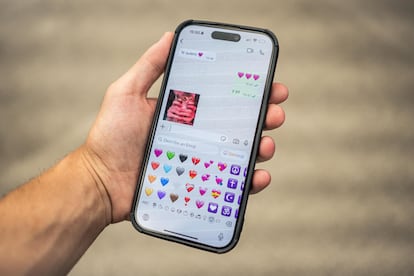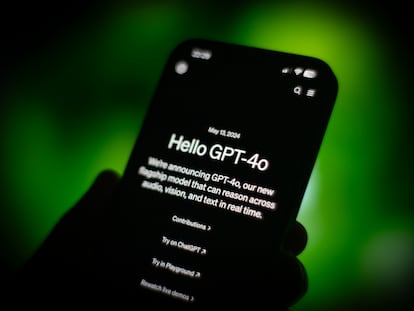People who use emojis seem more attentive: ‘They respond to a universal human need’
According to recent research, using these symbols makes individuals appear more emotionally involved, regardless of which ones they use

Emojis are a common element in messages and social media, but their importance for maintaining healthy relationships is underestimated. New research published in the scientific journal PLOS confirms how simply using them helps strengthen the connection between people.
“Emojis add an emotional touch to what we say, and in relationships, that touch is not just decorative: it can influence how much a person feels valued or understood,” says Sally Huh, a researcher at the University of Texas at Austin. “Emojis help recover some of the emotional warmth lost when we communicate only by text. Without voice, facial expressions, or gestures, messages can seem cold or dry,” she adds.
Huh confirmed this positive layer that emojis add to text-based relationships: her study involved 260 adults aged 23 to 67. She sent each participant 15 conversations, some containing emojis and others not, then asked them to rate the qualities of the participants. The result was that senders who used emojis were perceived as more attentive and emotionally engaged. The conclusion is clear: “This article shows that pairing written texts with emojis increases closeness and the recipient’s satisfaction,” says Celia Andreu Sánchez, professor at the Universitat Autònoma de Barcelona and reviewer of Huh’s paper.
In her research, Huh found that the type of emoji matters little, whether a face or another symbol. What matters is making sure messages include these little images, which add a gesture, a glance, or tone to communication.
“I found it surprising but interesting that there were no major differences in how relationships were perceived when using face emojis or non-face emojis,” says Huh. “It may be because both types can fulfill an emotional or relational function depending on context. Ultimately, what matters to give relational meaning to an emoji is that it fits the conversation, rather than the type of emoji it is,” she adds.
The very effort to find an emoji to add a nonverbal touch already helps. It’s like smiling after saying something. Even if the emoji is negative or counterproductive, like an angry or melancholy face. “Even a simple or neutral emoji conveys emotional effort and involvement. Although in some cases the exact emoji can matter, the most important thing is usually the emotional layer and sense of closeness it provides,” the researcher explains.
For all ages
What’s more, emojis play an important role regardless of age. “I was surprised there weren’t big generational differences. Young people may have popularized emojis, but older generations have quickly adopted them because they respond to a universal human need,” says Huh. Many adults had probably already expressed emotions in writing with smiley faces or creative punctuation to convey feelings.
Emojis are an advance over historical emoticons like :-) because they are “more visually expressive, they more closely resemble real facial expressions, and are easier to interpret,” notes Huh.
But recently, emojis had started to share space with stickers or gifs. The shift hasn’t fully happened. Emojis still have a role in written communication: “Emojis are more visual,” says Andreu Sánchez. “The increase in the technical possibilities of cell phone devices means that the ‘visual art’ of this type of communication has become increasingly complex and rich. Stickers offer a high degree of personalization, and that, in the society we live in, is a positive thing.”
In the end, however, all serve to give a warmth that plain text cannot provide, Huh believes: “Although stickers and gifs have become very popular, they coexist perfectly with emojis. Stickers can convey even stronger emotions or a more specific, personal style, but fundamentally they fulfill a similar function: adding warmth, personality, and emotional nuance to digital messages. Overall, both stickers and emojis help humanize text and likely have a similar effect on making people feel seen and understood.”
Sign up for our weekly newsletter to get more English-language news coverage from EL PAÍS USA Edition
Tu suscripción se está usando en otro dispositivo
¿Quieres añadir otro usuario a tu suscripción?
Si continúas leyendo en este dispositivo, no se podrá leer en el otro.
FlechaTu suscripción se está usando en otro dispositivo y solo puedes acceder a EL PAÍS desde un dispositivo a la vez.
Si quieres compartir tu cuenta, cambia tu suscripción a la modalidad Premium, así podrás añadir otro usuario. Cada uno accederá con su propia cuenta de email, lo que os permitirá personalizar vuestra experiencia en EL PAÍS.
¿Tienes una suscripción de empresa? Accede aquí para contratar más cuentas.
En el caso de no saber quién está usando tu cuenta, te recomendamos cambiar tu contraseña aquí.
Si decides continuar compartiendo tu cuenta, este mensaje se mostrará en tu dispositivo y en el de la otra persona que está usando tu cuenta de forma indefinida, afectando a tu experiencia de lectura. Puedes consultar aquí los términos y condiciones de la suscripción digital.
More information
Archived In
Últimas noticias
Welcome to the post-religion era: The idea of Christianity as the absolute truth has become obsolete
‘I thought you would like it’: The risky sexual practice popularized by TV shows and TikTok
The digitalization of tourism: ‘They promise experiences and gave us the worst possible one’
Mexican peso defies uncertainty with forecasts of a new period of stability in 2026
Most viewed
- Sinaloa Cartel war is taking its toll on Los Chapitos
- Reinhard Genzel, Nobel laureate in physics: ‘One-minute videos will never give you the truth’
- Oona Chaplin: ‘I told James Cameron that I was living in a treehouse and starting a permaculture project with a friend’
- Why the price of coffee has skyrocketed: from Brazilian plantations to specialty coffee houses
- Silver prices are going crazy: This is what’s fueling the rally











































